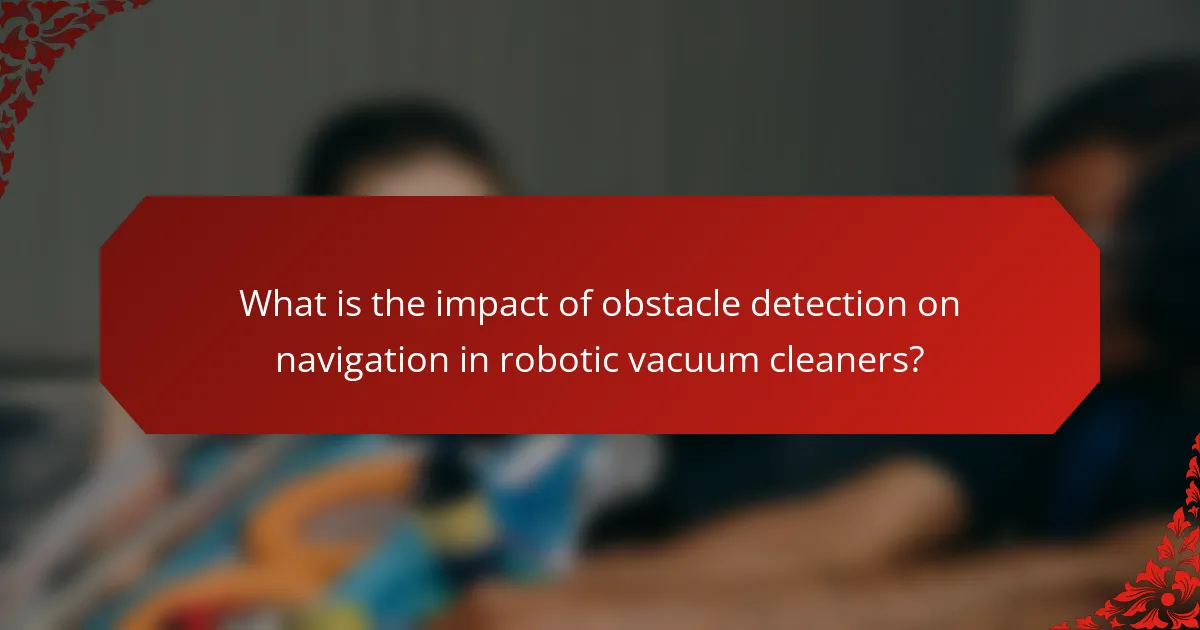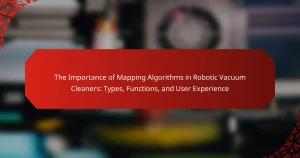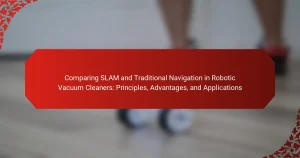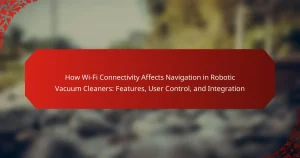Obstacle detection is a critical feature in robotic vacuum cleaners that enhances navigation by enabling these devices to identify and avoid obstacles such as furniture and walls. This capability not only reduces collision risks but also promotes more efficient cleaning patterns and minimizes potential damage to both the vacuum and the environment. Advanced sensors, including LIDAR technology, facilitate the mapping of complex spaces and the creation of optimal cleaning routes. The article examines the techniques, challenges, and solutions associated with obstacle detection systems, highlighting their impact on overall performance and user satisfaction in robotic vacuum cleaners.

What is the impact of obstacle detection on navigation in robotic vacuum cleaners?
Obstacle detection significantly enhances navigation in robotic vacuum cleaners. It allows these devices to identify and avoid obstacles in their path. This capability reduces the likelihood of collisions with furniture, walls, and other items. Effective obstacle detection leads to more efficient cleaning patterns. It also minimizes the risk of damage to both the vacuum and the surroundings. Studies show that robotic vacuums with advanced sensors can navigate complex environments more effectively. For instance, models using LIDAR technology can map rooms and create optimal cleaning routes. The integration of obstacle detection systems results in improved overall performance and user satisfaction.
How does obstacle detection technology function in robotic vacuum cleaners?
Obstacle detection technology in robotic vacuum cleaners functions by utilizing sensors to identify and navigate around obstacles. These sensors include infrared, ultrasonic, and laser-based technologies. Infrared sensors emit signals to detect nearby objects. Ultrasonic sensors use sound waves to measure distances to obstacles. Laser-based sensors, often found in advanced models, create a detailed map of the environment.
The data collected by these sensors allows the vacuum cleaner to adjust its path in real-time. For example, when an object is detected, the robot may change direction or slow down to avoid collisions. This technology enhances the efficiency of cleaning by ensuring that the vacuum can operate without getting stuck or damaged.
Research indicates that robotic vacuum cleaners equipped with advanced obstacle detection systems can navigate complex environments more effectively. A study published in the journal “Robotics and Autonomous Systems” highlights the importance of these technologies in improving navigation performance.
What are the primary sensors used for obstacle detection?
The primary sensors used for obstacle detection include ultrasonic sensors, infrared sensors, and LIDAR sensors. Ultrasonic sensors emit sound waves and measure the time taken for the echo to return. This allows them to detect nearby objects by calculating distance. Infrared sensors detect heat emitted by objects, which helps in identifying obstacles based on thermal signatures. LIDAR sensors use laser beams to create a detailed 3D map of the environment, allowing for precise obstacle detection. These sensors are commonly used in robotic vacuum cleaners to navigate efficiently and avoid collisions.
How do these sensors communicate with the navigation system?
Sensors communicate with the navigation system through data transmission protocols. These protocols include wired connections, such as I2C or SPI, and wireless methods like Bluetooth or Wi-Fi. Sensors collect environmental data, such as distance and obstacles. They then send this data to the navigation system for processing. The navigation system interprets this information to adjust the robot’s path. This process enhances the robot’s ability to navigate effectively. For example, ultrasonic sensors measure distance and relay this data in real-time. This real-time communication allows for immediate adjustments to the robot’s movement.
What challenges do robotic vacuum cleaners face with obstacle detection?
Robotic vacuum cleaners face several challenges with obstacle detection. One major challenge is the variety of surfaces and objects in homes. Different colors, textures, and shapes can confuse sensors. Another challenge is low-light conditions that hinder the effectiveness of visual sensors. Additionally, small or transparent objects may go undetected. Sensor limitations can lead to collisions or missed areas during cleaning. Furthermore, complex layouts with multiple obstacles complicate navigation. Inconsistent performance across different environments is also a significant issue. These challenges affect the efficiency and reliability of robotic vacuum cleaners.
What types of obstacles are most problematic for robotic vacuum cleaners?
Robotic vacuum cleaners struggle with various types of obstacles. Thick carpets can impede movement and cause the device to get stuck. Cords and small objects can entangle the vacuum, disrupting its operation. Uneven surfaces, such as thresholds or stairs, pose a risk of falling or malfunctioning. Additionally, low furniture can limit the vacuum’s ability to navigate effectively. These obstacles hinder the efficiency and performance of robotic vacuum cleaners.
How do environmental factors influence obstacle detection accuracy?
Environmental factors significantly influence obstacle detection accuracy. Factors such as lighting conditions, surface texture, and clutter level directly affect sensor performance. For instance, low light can hinder camera-based detection systems, leading to missed obstacles. Similarly, reflective surfaces may confuse sensors, resulting in incorrect readings. Cluttered environments can obstruct sensor lines of sight, making detection more challenging. Research indicates that robotic vacuum cleaners perform best in well-lit, open spaces. According to a study by Kim et al. (2021), obstacle detection accuracy drops by up to 30% in poorly lit or cluttered environments. These findings underscore the importance of optimizing environmental conditions for effective obstacle detection.
What are the solutions to improve obstacle detection in robotic vacuum cleaners?
Solutions to improve obstacle detection in robotic vacuum cleaners include advanced sensors, machine learning algorithms, and improved mapping techniques. Advanced sensors, such as LiDAR and ultrasonic sensors, enhance the vacuum’s ability to detect obstacles at various distances. Machine learning algorithms can analyze data from these sensors to identify and classify obstacles more accurately. Improved mapping techniques, like simultaneous localization and mapping (SLAM), allow vacuum cleaners to create detailed maps of their environment. These maps help the robots navigate around obstacles effectively. Research indicates that integrating these technologies significantly reduces collision rates and enhances overall navigation efficiency.
What advancements in sensor technology enhance obstacle detection?
Advancements in sensor technology that enhance obstacle detection include LiDAR, ultrasonic sensors, and computer vision systems. LiDAR provides precise distance measurements by using laser light, allowing robotic vacuum cleaners to create detailed maps of their environment. Ultrasonic sensors emit sound waves to detect nearby objects, enabling effective distance measurement and obstacle avoidance. Computer vision systems utilize cameras and advanced algorithms to identify and classify obstacles in real-time. These technologies improve navigation accuracy and efficiency in robotic vacuum cleaners. According to a study published in the “Journal of Robotics,” integrating these sensor technologies significantly reduces collision rates and enhances overall cleaning performance.
How can software algorithms improve navigation and obstacle avoidance?
Software algorithms enhance navigation and obstacle avoidance by processing sensor data in real-time. They utilize techniques like pathfinding algorithms to determine the most efficient route. Algorithms such as A* and Dijkstra’s enable effective navigation through complex environments. Machine learning models improve obstacle recognition by analyzing patterns in sensor data. These models adapt to various surfaces and obstacles, increasing accuracy. Additionally, algorithms can predict potential collisions and reroute accordingly. For example, LIDAR-based systems offer precise distance measurements, allowing for better obstacle detection. The integration of these algorithms results in smoother navigation and reduced collision rates in robotic vacuum cleaners.
How do different navigation techniques impact the effectiveness of obstacle detection?
Different navigation techniques significantly influence the effectiveness of obstacle detection in robotic vacuum cleaners. For instance, laser-based navigation systems provide precise distance measurements, enhancing the ability to identify obstacles. In contrast, infrared navigation techniques may struggle with reflective surfaces, leading to missed detections.
Additionally, visual navigation methods utilize cameras to recognize obstacles, but their performance can be affected by lighting conditions. Studies show that robots using simultaneous localization and mapping (SLAM) techniques demonstrate improved obstacle detection accuracy in dynamic environments.
Moreover, the integration of multiple navigation techniques can create a more robust obstacle detection system. For example, combining laser and visual data can reduce the limitations of each method alone. Overall, the choice of navigation technique directly impacts how effectively a robotic vacuum cleaner can detect and avoid obstacles.
What are the various navigation methods used in robotic vacuum cleaners?
Robotic vacuum cleaners utilize several navigation methods. These methods include random navigation, systematic navigation, and smart navigation.
Random navigation allows the robot to move in a seemingly haphazard manner. It relies on bump sensors to change direction upon contact with obstacles. This method is less efficient and can lead to missed areas.
Systematic navigation employs a grid or linear pattern for cleaning. The robot moves in straight lines and covers the entire area more methodically. This method improves coverage and efficiency compared to random navigation.
Smart navigation involves advanced technologies like laser mapping and camera vision. These systems create a map of the environment and allow for real-time adjustments. Smart navigation enhances obstacle detection and improves cleaning routes.
Each navigation method has its advantages and limitations. Random navigation is simple but inefficient. Systematic navigation is more effective but can be slower. Smart navigation is the most advanced, providing optimal cleaning efficiency.
How do these methods interact with obstacle detection capabilities?
Obstacle detection methods enhance navigation capabilities in robotic vacuum cleaners. These methods utilize sensors such as LIDAR, ultrasonic, and infrared to identify obstacles. By detecting obstacles, robotic vacuums can alter their paths effectively. This interaction prevents collisions and improves cleaning efficiency. For example, LIDAR systems create detailed maps of the environment. This mapping allows for better navigation around furniture and other barriers. Furthermore, obstacles detected in real-time enable the vacuum to adapt its movement. This adaptability is crucial for thorough cleaning in complex spaces. Overall, effective obstacle detection directly influences the performance and reliability of robotic vacuum cleaners.
What best practices can users follow to optimize obstacle detection in their robotic vacuum cleaners?
To optimize obstacle detection in robotic vacuum cleaners, users should ensure a clear path for the device. Removing small objects like toys or cables prevents interference with sensors. Regularly cleaning the sensors enhances their performance. Users should also update the vacuum’s software to benefit from improvements in detection algorithms. Keeping the vacuum’s wheels and brushes free of debris aids in accurate navigation. Users can also schedule cleaning sessions during times of low foot traffic to minimize obstacles. Additionally, utilizing virtual barriers can help define areas to avoid. Following these practices can significantly enhance obstacle detection efficiency.
The main entity of the article is obstacle detection in robotic vacuum cleaners, which plays a crucial role in enhancing navigation capabilities. The article examines how various sensor technologies, including ultrasonic, infrared, and LIDAR, function to detect obstacles and improve cleaning efficiency. It also addresses the challenges faced by these devices in diverse environments and outlines solutions such as advanced sensors and machine learning algorithms to enhance obstacle detection accuracy. Furthermore, best practices for users are provided to optimize the performance of robotic vacuum cleaners in navigating around obstacles.


